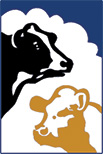Myostatin Gene – Double Muscling
by Brian Kennedy MVB, DBR, MRCVS, FrAgs, Company Veterinarian
Most traits in cattle such as growth, fertility and health are influenced by multiple genes. A few such as polledness and coat colour are controlled by a single pair of genes, as is double muscling.
Myostatin is a protein which acts on the autocrine function within muscle cells to inhibit cell growth and differentiation. Where natural mutations of the gene occur the proteins produced are less effective in controlling muscle development, which results in increased muscle mass.
Within the UK and Ireland nine different variations of the myostatin gene have been identified. Because genes occur in pairs the significance of a single defective gene often depends on the other gene in the pairing. Where two genes are the same the animal is described as homozygous and where different heterozygous.
Dominance
Most single gene traits have a dominant and recessive form. In the case of polledness for example, the polledness gene (P) is dominant. For an animal to be horned it would have to carry two recessive genes (pp). Where an animal is either homozygous (PP) or heterozygous (Pp) it will be polled.
Myostatin Variants
The situation with myostatin is complicated. The different variants can be recessive or partially dominant and in many non-pedigree situations the genetic status of a herd unknown.
Advantages
Myostatin mutations offer a number of benefits to the livestock world.
- Higher kill out percentages
- Improved food conversion efficiency when muscle weight gain per unit is taken into account
- Higher polyunsaturated fat content
Disadvantages
- Heavier birth weights with difficult calvings
- Enlarged tongues in newborn calves
- Smaller genitalia, reduced fertility
- Shorter, thinner, less dense bones more susceptible to fracture
- Prone to respiratory conditions / pneumonia
Gene Frequency
There is a significant difference in the prevalence of gene variants across the beef breeds in the UK and Ireland. Variant F94L is most common and is generally considered to offer most of the benefits with least of the drawbacks.
Testing
It is clear that the variants of the myostatin gene have a lot to offer. However disseminating their genes must be done in a controlled manner. The genetic constitution of both sire and dam must be confirmed prior to every mating if the benefits of the myostatin gene are to be realized without unwanted consequences.

